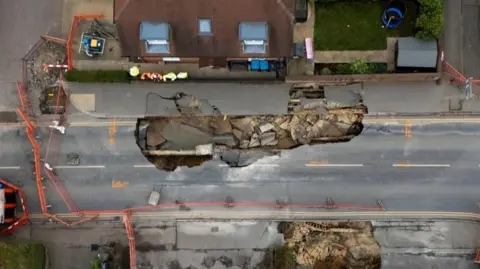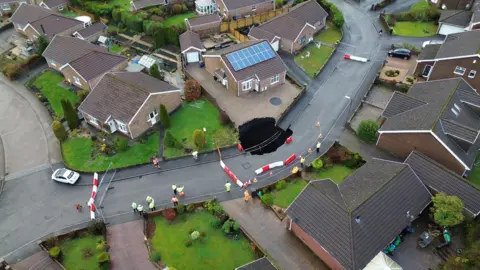Climate and science reporter, BBC News
 PA Media
PA MediaResidents in the Surrey village of Godstone have been evacuated after two sinkholes opened up this week along large parts of the high street.
The original hole first appeared late on Monday night, growing to at least 65ft (20m) long by Tuesday lunchtime.
Sinkholes are not uncommon in the UK but can sometimes appear suddenly. What might be the causes and should we be more worried about them?
What is a sinkhole?
A sinkhole is a depression in the surface because the underlying rock has collapsed.
They can be saucer-shaped or appear deeper more like shafts. If they occur in built-up areas they can appear more irregular as a road or another structure above can distort the shape.
In Godstone, the collapsed ground is under a road which is partially concealing the size of the depression.
How are they formed?
Sinkholes can appear for many different reasons – it is often due to the geology but human factors can also be a cause.
One of the most common reasons for a sinkhole is when rocks like limestone or chalk break down. This happens because carbon dioxide from the air dissolves in rainwater to form carbonic acid – this then percolates through the rock and reacts with it, causing it to dissolve.
Sometimes this process can happen gradually, where the depression becomes larger over time.
In other instances, the limestone sits below another layer of rock, which means that as it gets dissolved there are no immediate signs at the surface.
The overlying rock, sometimes clay or sandstone, will then suddenly collapse into the depression beneath – called a ‘collapse sinkhole’.
These are most common in South Wales where sandstone rocks lie above caves in the limestone.
But human activities can also accelerate the formation of sinkholes or cause the ground to collapse in a similar way.
Andrew Farrant, British Geological Survey regional geologist for south-east England, suspects that is what has happened in Godstone and it is not a true sinkhole.
He said that one theory is that a burst water main has caused a sudden influx of water into the sandstone bed “flushing” the rock out the way.
Pete Burgess, of the Wealden Cave and Mines Society, said a quarry marked “sand pit” can be seen on 19th century maps of land directly under the sinkhole.
He added that sand from the pit was dug out and used for building and gardening purposes.
Mr Farrant said that sand pit had been filled in but he added that there had been a significant amount of historic mining in the area and it cannot be ruled out that there were some unmapped pits and quarries that have been built on.
How common are sinkholes in the UK?
They are common in the UK because of the abundance of limestone and chalk rock and historic mining activities.
Limestone and chalk are formed from the deposit and compression of micro-organisms found in shallow warm seas. Millions of years ago the UK was located further south towards the equator and was much warmer with parts of the country submerged – creating the ideal conditions for these rock types to form.
Vanessa Banks, expert in shallow geohazards and risks at the British Geological Survey, told the BBC’s Radio 4 PM programme: “Sinkholes occur in spates but many are not recorded as they occur in remote areas.”
She added that meteorological conditions play a role as extreme downpours can flush water through the rocks or put pressure on infrastructure like water mains.
Last December, about 30 homes were evacuated in Merthyr Tydfil after the ground collapsed, and in 2014 sinkholes occurred at five to ten times the normal rate across south-east England after intense storm conditions.
 Eye in the Sky
Eye in the SkyAre they dangerous?
‘Collapse sinkholes’ which can appear suddenly and without any warnings at the surface, like cracks or subsidence, can be dangerous.
In 2010, a sinkhole measuring 20m in diameter and 90m deep, appeared in Guatemala City which resulted in the death of one person. In this case heavy rains and poor drainage are thought to have weakened the underlying rock.
And in January a truck driver had to be rescued in the Japanese city of Yashio after the ground collapsed due to a burst pipe.
In the case of dissolution sinkholes geologists can indicate which areas are more at risk if the underlying rock is made up of chalk or limestone. For any new development in the UK the local planning authority does review the geology and any potential risks.
But Dr Collins, reader in geology and geotechnical engineering at Brunel University, said that in this case where water infrastructure plays a role it is harder to predict potential ground collapses.
“The pipe rupture does highlight the challenge that comes with having buried infrastructure as they are often buried at depths in excess of a metre. The depth is to reduce the impact of deep freeze during a very cold winter.
“Unfortunately, this makes them hard to monitor and repairs can be difficult, including the replacement of soil in the excavated hole once the repair is complete,” he said.
 Reuters
Reuters







